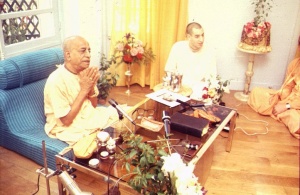CC Madhya 6.120 (1975): Difference between revisions
(Vanibot #0027: CCMirror - Mirror CC's 1996 edition to form a basis for 1975) |
(Vanibot #0020: VersionCompareLinker - added a link to the Version Compare feature) |
||
| Line 2: | Line 2: | ||
<div style="float:left">'''[[Sri Caitanya-caritamrta (1975)|Śrī Caitanya-caritāmṛta (1975)]] - [[CC Madhya (1975)|Madhya-līlā]] - [[CC Madhya 6 (1975)|Chapter 6: The Liberation of Sārvabhauma Bhaṭṭācārya]]'''</div> | <div style="float:left">'''[[Sri Caitanya-caritamrta (1975)|Śrī Caitanya-caritāmṛta (1975)]] - [[CC Madhya (1975)|Madhya-līlā]] - [[CC Madhya 6 (1975)|Chapter 6: The Liberation of Sārvabhauma Bhaṭṭācārya]]'''</div> | ||
<div style="float:right">[[File:Go-previous.png|link=CC Madhya 6.119 (1975)|Madhya-līlā 6.119]] '''[[CC Madhya 6.119 (1975)|Madhya-līlā 6.119]] - [[CC Madhya 6.121 (1975)|Madhya-līlā 6.121]]''' [[File:Go-next.png|link=CC Madhya 6.121 (1975)|Madhya-līlā 6.121]]</div> | <div style="float:right">[[File:Go-previous.png|link=CC Madhya 6.119 (1975)|Madhya-līlā 6.119]] '''[[CC Madhya 6.119 (1975)|Madhya-līlā 6.119]] - [[CC Madhya 6.121 (1975)|Madhya-līlā 6.121]]''' [[File:Go-next.png|link=CC Madhya 6.121 (1975)|Madhya-līlā 6.121]]</div> | ||
{{CompareVersions|CC|Madhya 6.120|CC 1975|CC 1996}} | |||
{{RandomImage}} | {{RandomImage}} | ||
==== TEXT 120 ==== | ==== TEXT 120 ==== | ||
| Line 11: | Line 10: | ||
<div class="verse"> | <div class="verse"> | ||
:vedānta paḍāite tabe ārambha karilā | :vedānta paḍāite tabe ārambha karilā | ||
:sneha-bhakti | :sneha-bhakti kari' kichu prabhure kahilā | ||
</div> | </div> | ||
| Line 18: | Line 17: | ||
<div class="synonyms"> | <div class="synonyms"> | ||
vedānta—Vedānta philosophy; paḍāite—to instruct; tabe—then; ārambha—beginning; karilā—made; sneha—affection; bhakti—and devotion; | vedānta—Vedānta philosophy; paḍāite—to instruct; tabe—then; ārambha—beginning; karilā—made; sneha—affection; bhakti—and devotion; kari'-showing; kichu—something; prabhure—unto the Lord; kahilā—said. | ||
</div> | </div> | ||
| Line 32: | Line 31: | ||
<div class="purport"> | <div class="purport"> | ||
The Vedānta- or Brahma-sūtra, written by Śrīla Vyāsadeva, is a book studied by all advanced spiritual students, especially by the sannyāsīs of all religious communities (sampradāyas). The sannyāsīs must read the Vedānta-sūtra to establish their final conclusions concerning Vedic knowledge. Here, of course, the Vedānta mentioned is the commentary of Śaṅkarācārya, known as Śārīraka-bhāṣya. Sārvabhauma Bhaṭṭācārya intended to convert Caitanya Mahāprabhu, who was a Vaiṣṇava sannyāsī, into a Māyāvādī sannyāsī. He therefore made this arrangement to instruct Him in the Vedānta-sūtra according to the Śārīraka commentary of Śaṅkarācārya. All the sannyāsīs of the Śaṅkara-sampradāya enjoy seriously studying the Vedānta-sūtra with the Śārīraka-bhāṣya commentary. It is said, vedānta-vākyeṣu sadā ramantaḥ: | The Vedānta- or Brahma-sūtra, written by Śrīla Vyāsadeva, is a book studied by all advanced spiritual students, especially by the sannyāsīs of all religious communities (sampradāyas). The sannyāsīs must read the Vedānta-sūtra to establish their final conclusions concerning Vedic knowledge. Here, of course, the Vedānta mentioned is the commentary of Śaṅkarācārya, known as Śārīraka-bhāṣya. Sārvabhauma Bhaṭṭācārya intended to convert Caitanya Mahāprabhu, who was a Vaiṣṇava sannyāsī, into a Māyāvādī sannyāsī. He therefore made this arrangement to instruct Him in the Vedānta-sūtra according to the Śārīraka commentary of Śaṅkarācārya. All the sannyāsīs of the Śaṅkara-sampradāya enjoy seriously studying the Vedānta-sūtra with the Śārīraka-bhāṣya commentary. It is said, vedānta-vākyeṣu sadā ramantaḥ: "One should always enjoy the studies of the Vedānta-sūtra." | ||
</div> | </div> | ||
Latest revision as of 18:29, 27 January 2020

A.C. Bhaktivedanta Swami Prabhupada
TEXT 120
- vedānta paḍāite tabe ārambha karilā
- sneha-bhakti kari' kichu prabhure kahilā
SYNONYMS
vedānta—Vedānta philosophy; paḍāite—to instruct; tabe—then; ārambha—beginning; karilā—made; sneha—affection; bhakti—and devotion; kari'-showing; kichu—something; prabhure—unto the Lord; kahilā—said.
TRANSLATION
He then began to instruct Lord Caitanya Mahāprabhu on Vedānta philosophy, and out of affection and devotion, he spoke to the Lord as follows.
PURPORT
The Vedānta- or Brahma-sūtra, written by Śrīla Vyāsadeva, is a book studied by all advanced spiritual students, especially by the sannyāsīs of all religious communities (sampradāyas). The sannyāsīs must read the Vedānta-sūtra to establish their final conclusions concerning Vedic knowledge. Here, of course, the Vedānta mentioned is the commentary of Śaṅkarācārya, known as Śārīraka-bhāṣya. Sārvabhauma Bhaṭṭācārya intended to convert Caitanya Mahāprabhu, who was a Vaiṣṇava sannyāsī, into a Māyāvādī sannyāsī. He therefore made this arrangement to instruct Him in the Vedānta-sūtra according to the Śārīraka commentary of Śaṅkarācārya. All the sannyāsīs of the Śaṅkara-sampradāya enjoy seriously studying the Vedānta-sūtra with the Śārīraka-bhāṣya commentary. It is said, vedānta-vākyeṣu sadā ramantaḥ: "One should always enjoy the studies of the Vedānta-sūtra."